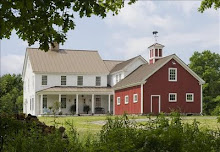December 2, 2009
Concrete Countertops - A Renewable Alternative to Marble
After pouring through the pages of interior design magazines, it is hard to ignore the beauty of natural stone countertops, (particularly white marble, which is so hot these days), quarried and transported from far away places.
And yet, when making plans for the light and airy 10' kitchen island, along with the bath vanities of THE CONCORD GREEN HOME, the thought of pillaging the earth for a big slab of non-renewable stone, along with the energy consumed and pollution created to transport it over land and sea, had me thinking twice.
I decided to go with concrete countertops. They are made from renewable resources, are easily maintained, durable and have a look that is at once industrial and rugged, yet warm and mellow at the same time.
I reached out to several East Coast suppliers. I fell in love with the samples from J. Aaron Cast Stone as soon as they arrived. They can create a countertop with any shape, in any color (light colors seem harder to find in concrete).
Plus, J. Aaron has developed a "stainless concrete" formula that eliminates the biggest disadvantage of concrete, while maintaining its soft patina. As the company's website explains:
For centuries, concrete has offered a beautiful alternative to natural stone for a variety of surfaces. As a counter top it has always been durable and extremely versatile with the one drawback being the tendency to etch when exposed to acids such as wine, citrus, vinegar and coffee. The look that results can be unsightly. Until now, the alternative was to coat the concrete with a topical sealer such as the epoxies many companies use. This does end the etching but... it smothers the original texture while stopping the natural patina process that makes concrete grow more beautiful with age.
Our exclusive stainless concrete solves this problem. It offers the best of both worlds, allowing the lovely texture of the material to remain and take on a slow natural patina though usage while stopping the etching effect of acids.
No wonder the samples are so lovely. I am pleased to welcome J. Aaron, a company whose products fit with THE CONCORD GREEN HOME's mission and aesthetic, as our 8th sponsor.
Anne Balogh, ConcreteNetwork.com Columnist, states "In addition to their versatility and distinctive beauty, concrete countertops have another virtue that appeals to many people, especially the ecologically aware: They are more environmentally friendly, or "greener," than most other types of countertops."
"Solid surface materials are made of plastic, engineered quartz materials contain a synthetic resin binder, and granite and marble are nonrenewable mined resources. Concrete contains mostly just good old sand, rock and cement," says Jeff Girard, president of The Concrete Countertop Institute and one of the Concrete Network's technical experts."
Labels:
green building,
healthy house,
interior design,
kitchens,
sustainable
Subscribe to:
Post Comments (Atom)





































Oh, I love these counters and we will be renovating our kitchen!
ReplyDeletepve
There are many different benefits of using granite vanities. They are durable, unlike other types of products used for coverings of vanities and similar areas, this product is resistant to scratches. You can get Custom Granite Vanity Top as I have get and add decor to your bathroom or kitchen.
ReplyDeleteThese are very cool concrete counters, but do they cost less than other counters?
ReplyDeleteTemporary Walls - Your question about cost is a good one. The answer is-- it depends. I would suggest getting quotes from 2-3 vendors. Be sure to include delivery and installation in your final calculation, since they can be a large percentage of the total, given the weight.
ReplyDeleteBest of luck to you.
Lisa